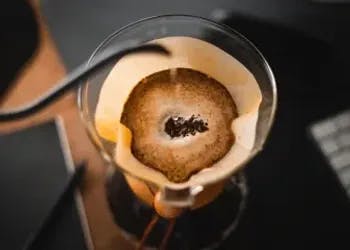
3 Best Coffee-to-Water Ratio For Pour-Over

Starting to brew pour-over coffee at home can be overwhelming, especially when it comes to figuring out the coffee-to-water ratio. Getting the right balance between the amount of coffee and water you use is essential for brewing a delicious cup of coffee.
If you're new to pour-over brewing and seeking guidance on achieving a consistently delightful cup, this guide is here to help you.
Understanding the basics
Transitioning from pre-packaged coffee to pour-over brewing means gaining control over the strength, taste, and overall quality of your cup of joe. With its precise and controlled process, pour-over brewing offers a rich and nuanced coffee experience.
The key lies in finding the delicate balance between the right amount of coffee grounds and water, allowing the flavors to fully bloom. The right ratio can extract the ideal flavors and aromas from your beans, creating a delightful experience with each sip. So, let's begin!
What is the best coffee-to-water ratio for pour-over?
When it comes to pour-over brewing, consistency reigns supreme. It's important to develop a routine and maintain it with precision. However, the coffee-to-water ratio is the fundamental building block that sets the stage for consistency. Let's explore the different ratios and their impact on the final cup of coffee.
1) The Classic: 1:15
The classic coffee-to-water ratio for pour-over brewing is 1:15, which means using one gram of coffee for every 15 grams of water. This ratio strikes a balance between strength and extraction, producing a well-rounded and flavorful cup. It's a great starting point for beginners to get a taste of the pour-over technique.
2) The bold and strong: 1:12
If you prefer a bolder and stronger brew, you may want to experiment with a 1:12 coffee-to-water ratio. This ratio increases the coffee grounds' concentration, resulting in a more robust flavor profile. It's perfect for those who enjoy a punchy and full-bodied cup of coffee that wakes up your taste buds.
3) The delicate and floral: 1:18
On the other end of the spectrum, we have the delicate and floral brews achieved with a 1:18 coffee-to-water ratio. This ratio emphasizes the subtle nuances of the coffee beans, accentuating their floral and fruity notes. It's an excellent choice for light-roasted beans and those who appreciate a more nuanced and tea-like cup of coffee.
4) Finding your sweet spot
Now that we've explored some popular coffee-to-water ratios, it's time for you to embark on your pour-over adventure. While these ratios provide a solid starting point, remember that coffee brewing is an art form, and personal preferences vary. Don't be afraid to experiment with different ratios, adjust the grind size, and explore various beans to find your sweet spot.
Factors that affect the coffee-to-water ratio for pour-over
When it comes to achieving that perfect cup of pour-over coffee, several factors come into play. Let's explore the key elements that influence the delicate balance between coffee and water in this enchanting brewing method.
1) Roast level
First and foremost, the coffee roast level sets the tone for your brew. Lighter roasts tend to possess vibrant flavors that are more delicate and nuanced, requiring a higher coffee-to-water ratio. On the other hand, darker roasts boast bolder and more robust flavors, necessitating a lower ratio to strike the ideal equilibrium.
2) Grind size
Another crucial factor is the grind size. A finely ground coffee will extract more quickly, resulting in a stronger brew, whereas a coarser grind will lead to a slower extraction, producing a milder cup. By adjusting the grind size, you have the power to manipulate the intensity of your coffee, subsequently affecting the necessary ratio.
3) Brewing method
The brew method used also has a significant impact on the coffee-to-water ratio. For example, a faster brewing method like a Hario V60 will require a higher ratio of coffee to water to achieve the desired flavor, while a slower brewing method like a Chemex will require a lower ratio of coffee to water.
How to pour water over coffee grounds correctly?
Let's equip ourselves with the necessary tools and follow a step-by-step method to ensure an accurate and delightful brewing experience.
To begin, you'll need a trustworthy scale and a reliable kettle for measuring both the coffee and water precisely. Having these tools at your disposal guarantees consistency and removes any guesswork from the equation.
Step 1: Weigh the desired amount of coffee beans
The first step for accurately measuring the coffee-to-water ratio is weighing the beans. Start by weighing your desired amount of coffee beans. Aim for a ratio of 1:16 as a starting point, meaning 1 gram of coffee for every 16 grams of water. Of course, feel free to experiment and adjust this ratio according to your taste preferences.
Step 2: Grind your coffee to the appropriate size
Since you are brewing pour-over coffee, consider the factors we discussed earlier. Remember that a finer grind demands a shorter extraction time, while a coarser grind requires a longer brew.
Step 3: Put the brewing apparatus on the scale
So of now, you are ready with the perfect coffee grounds for pour-over. Place your brewing apparatus atop the scale and zero it out. This will ensure that you're only measuring the water you add, excluding the weight of the vessel.
Step 4: Gradually pour the preheated water over the coffee
Now, it is making sure to maintain a consistent and steady pour. As you do so, keep an eye on the scale to ensure you're adding the appropriate weight of water.
By following these simple steps and adjusting the ratio based on your taste and the factors we explored earlier, you'll embark on a journey to consistently brewing an exceptional cup of pour-over coffee. So go forth, measure mindfully, and savor every sip of your perfectly balanced creation.
Tips for refining your technique:
The coffee-to-water ratio is just one piece of the puzzle. To help you along the way, here are a few tips to refine your pour-over technique and achieve the best possible cup of coffee:
- Invest in a reliable coffee scale to measure your coffee and water accurately.
- Pay attention to the water temperature. Aim for around 195-205°F (90-96°C) for optimal extraction.
- Experiment with different pouring techniques, such as the gentle circular pour or the precise pulse pouring, to control the extraction process.
- Keep a brewing journal to record your experiments, noting the coffee-to-water ratio, grind size, and any adjustments made. This will help you track your progress and fine-tune your technique.
Wrapping up
Congratulations, you're now equipped with the knowledge to embark on your pour-over coffee journey! Remember, the ideal coffee-to-water ratio is subjective and can vary based on personal taste preferences and the coffee beans used. So, don't be afraid to experiment, savor, and enjoy the marvelous adventure that awaits you in each pour-over brew.

I am a barista by profession hailing from NC. My journey began in my late teens when I started working as a barista in a local coffee shop. My passion for coffee quickly became evident as I immersed myself in the art of espresso extraction, latte art ...



